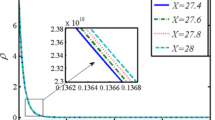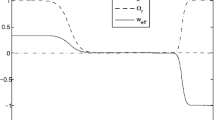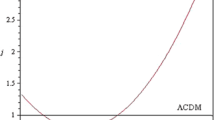Abstract
We have developed a Bianchi I cosmological model of the universe in f(R, T) gravity theory which fit good with the present-day scenario of accelerating universe. The model displays transition from deceleration in the past to the acceleration at the present. As in the \(\Lambda\)CDM model, we have defined the three energy parameters \(\Omega _m\), \(\Omega _{\mu }\) and \(\Omega _{\sigma }\) such that \(\Omega _m\) + \(\Omega _{\mu }\) + \(\Omega _{\sigma }\) = 1. The parameter \(\Omega _m\) is the matter energy density (baryons + dark matter), \(\Omega _{\mu }\) is the energy density associated with the Ricci scalar R and the trace T of the energy momentum tensor and \(\Omega _{\sigma }\) is the energy density associated with the anisotropy of the universe. We shall call \(\Omega _{\mu }\) dominant over the other two due to its higher value. We find that the \(\Omega _{\mu }\) and the other two in the ratio 3:1. 46 Hubble OHD data set is used to estimate present values of Hubble \(H_0\), deceleration \(q_0\) and jerk j parameters. 1\(\sigma\), 2\(\sigma\) and 3\(\sigma\) contour region plots for the estimated values of parameters are presented. 580 SNIa supernova distance modulus data set and 66 pantheon SNIa data which include high red shift data in the range \(0\le z\le 2.36\) have been used to draw error bar plots and likelihood probability curves for distance modulus and apparent magnitude of SNIa supernova’s. We have calculated the pressures and densities associated with the two matter densities, viz. \(p_{\mu }\), \(\rho _{\mu }\), \(p_m\) and \(\rho _m\), respectively. The present age of the universe as per our model is also evaluated, and it is found at par with the present observed values.




Similar content being viewed by others
Data availability statement
This manuscript has no associated data or the data will not be deposited.
References
A.G. Riess et al., [Supernova Search Team], Observational evidence from supernovae for an accelerating universe and a cosmological constant. Astron. J. 116, 1009–1038 (1998)
P.M. Garnavich et al., Constraints on cosmological models from hubble space telescope observations of high-z supernovae. Astrophys. J. 493, L53 (1998)
S. Perlmutter et al., [Supernova Cosmology Project], Measurements of \(\Omega\) and \(\Lambda\) from 42 high redshift supernovae. Astrophys. J. 517, 565–586 (1999)
A.G. Riess, Type Ia supernova discoveries at \(z > 1\) from the hubble space telescope: evidence for past deceleration and constraints on dark energy evolution\(^{*}\). Astrophys. J. 607, 665 (2004)
A.G. Tegmark et al., Cosmological parameters from SDSS and WMAP. Phys. Rev. D 69, 103501 (2004)
D.N. Spergel et al., First-year Wilkinson microwave anisotropy probe (WMAP)\(^*\) observations: determination of cosmological parameters. Astrophys. J. Suppl. Ser. 148, 175 (2003)
E. Calabrese, M. Migliaccio, L. Pagano, G. De Troia, A. Melchiorri, P. Natoli, Phys. Rev. D 80, 063539 (2009)
Y. Wang, M. Dai, Exploring uncertainties in dark energy constraints using current observational data with Planck 2015 distance priors. Phys. Rev. D 94, 083521 (2016)
M. Zhao, D. Ze He, J. Fei Zhang, X. Zhang, Search for sterile neutrinos in holographic dark energy cosmology: reconciling Planck observation with the local measurement of the Hubble constant, Phys. Rev. D 96, 043520 (2017)
B. Wang, E. Abdalla, F. Atrio-Barandela, D. Pavon, Dark matter and dark energy interactions: theoretical challenges, cosmological implications and observational signatures. Rep. Prog. Phys. 79, 096901 (2016)
P.J.E. Peebles, B. Ratra, The cosmological constant and dark energy. Rev. Mod. Phys. 75, 559 (2003)
T. Padmanabhan, Cosmological constant \(\Lambda\) the weight of the vacuum II. Phys. Rep. 380, 235 (2003)
E.J. Copeland, M. Sami, S. Tsujikawa, Dynamics of dark energy. Int. J. Mod. Phys. D 15, 1753 (2006)
M. Li, X.D. Li, S. Wang, Y. Wang, Dark energy: a brief review. Front. Phys. 8, 828 (2013)
S. Weinberg, Sources and detection of dark matter and dark energy in the universe: the cosmological constant problem (Springer, 2001), pp. 18-26
V. Sahni, The cosmological constant problem and quintessence. Class. Quantum Grav. 19, 3435 (2002)
J. Garriga, A. Vilenkin, Solutions to the cosmological constant problems. Phys. Rev. D 64, 023517 (2001)
J.A. Frieman, M.S. Turner, D. Huterer, Dark energy and the accelerating universe. Annu. Rev. Astron. Astrophys. 46, 385 (2008)
S. Nojiri, S.D. Odintsov, Unified cosmic history in modified gravity: from F (R) theory to Lorentz non-invariant models. Phys. Rep. 505, 59 (2011)
R. Caldwell, M. Kamionkowski, The physics of cosmic acceleration. Annu. Rev. Astron. Astrophys. 59, 397 (2009)
P.J.E. Peebles, B. Ratra, The cosmological constant and dark energy. Rev. Mod. Phys. 75, 559–606 (2003)
P. Steinhardt, L. Wang, I. Zlatev, Cosmological tracking solutions. Phys. Rev. D 59, 123504 (1999)
V.B. Johri, Genesis of cosmological tracker fields. Phys. Rev. D 63, 103504 (2001)
R.R. Caldwell, A phantom menace? Cosmological consequences of a dark energy component with super-negative equation of state. Phys. Lett. B 545, 23–29 (2002)
V.B. Johri, Phantom cosmologies. Phys. Rev. D 70, 041303 (2004)
H.R. Fazlollahi, Holographic dark energy from acceleration of particle horizon. Chin. Phys. C 47, 035101 (2023)
M. Li, X.D. Li, Y. Wang, X. Zhang, Probing interaction and spatial curvature in the holographic dark energy model. J. Cosmol. Astropart. Phys. 12, 014 (2009)
S. Nojiri, S.D. Odintsov, Introduction to modified gravity and gravitational alternative for dark energy. Phys. Rev. D 70, 103522 (2004)
S. Nojiri, S.D. Odintsov, S. Tsujikawa, Properties of singularities in the (phantom) dark energy universe. Phys. Rev. D 71, 063004 (2005)
S. Nojiri, S.D. Odintsov, Unifying phantom inflation with late-time acceleration: scalar phantom-non-phantom transition model and generalized holographic dark energy. Gen. Relat. Gravit. 38, 1285 (2006)
S. Nojiri, S.D. Odintsov, Properties of singularities in the (phantom) dark energy universe. Phys. Rev. D 72, 023003 (2005)
M. Li, A model of holographic dark energy. Phys. Lett. B 603, 1 (2004)
S. Nojiri, S.D. Odintsov, E.N. Saridakis, Modified cosmology from extended entropy with varying exponent. Eur. Phys. J. C 79, 242 (2019)
R.C. Nunes, E.M. Barboza Jr., E.M.C. Abreu, J.A. Neto, Probing the cosmological viability of non-gaussian statistics. J. Cosmol. Astropart. Phys. 08, 051 (2016)
A.K. Yadav, Note on Tsallis holographic dark energy in Brans-Dicke cosmology. Eur. Phys. J. C 81, 8 (2021)
T. Harko, F.S.N. Lobo, S. Nojiri, S.D. Odintsov, f(R, T) gravity. Phys. Rev. D 84, 024020 (2011)
T. Harko, Thermodynamic interpretation of the generalized gravity models with geometry-matter coupling. Phys. Rev. D 90, 044067 (2014)
V.K. Bhardwaj, A.K. Yadav, Some Bianchi type-V accelerating cosmological models in \(f(R, T) = f_{1}(R) + f_{2}(T)\) formalism. Int. J. Geom. Methods Mod. Phys. 17, 2050159 (2020)
T. Tangphati, G. Panotopoulos, A. Banerjee, A. Pradhan, Charged compact stars with colour-flavour-locked strange quark matter in f(R, T) gravity. Chin. J. Phys. 82, 62–74 (2023)
L.K. Sharma, A.K. Yadav, B.K. Singh, Power-law solution for homogeneous and isotropic universe in f (R, T) gravity. New Astron. 79, 101396 (2020)
A. Pradhan, G.K. Goswami, R. Rani, A. Beesham, An f(R, T) gravity based FLRW model and observational constraints, arXiv:2210.15433v1 [gr-qc] 26 Oct (2022)
L.K. Sharma, A.K. Yadav, P.K. Sahoo, B.K. Singh, Non-minimal matter-geometry coupling in Bianchi I space-time. Results Phys. 10, 738 (2018)
J.M.Z. Pretel, T. Tangphati, A. Banerjee, A. Pradhan, Charged quark stars in f(R, T) gravity. Chin. Phys. C 46, 115103 (2022)
V.K. Bhardwaj, A. Pradhan, Evaluation of cosmological models in \(f(R, T)\) gravity in different dark energy scenario. New Astron. 91, 101675 (2022)
S. Nojiri, S.D. Odintsov, Unified cosmic history in modified gravity: from F(R) theory to Lorentz non-invariant models. Phys. Rep. 505, 59 (2011)
S.M. Carroll, V. Duvvuri, M. Trodden, M.S. Turner, Is cosmic speed-up due to new gravitational physics? Phys. Rev. D 70, 043528 (2004)
S.K. Srivastava, Scale factor dependent equation of state for curvature inspired dark energy, phantom barrier and late cosmic acceleration. Phys. Lett. B 643, 1–4 (2006)
W. Hu, I. Sawicki, Models of f(R) cosmic acceleration that evade solar system tests. Phys. Rev. D 76, 064004 (2007)
S. Nojiri, S.D. Odintsov, Modified gravity with negative and positive powers of curvature: Unification of inflation and cosmic acceleration. Phys. Rev. D 68, 123512 (2003)
S. Capozziello, V.F. Cardone, A. Troisi, Dark energy and dark matter as curvature effects? J. Cosmol. Astropart. Phys. 08, 001 (2006)
C.F. Martins, P. Salucci, Analysis of rotation curves in the framework of \(R^n\) gravity. Mon. Not. R. Astron. Soc. 381, 1103 (2007)
C.G. B\(\ddot{o}\)hmer, T. Harko, F.S.N. Lobo, Dark matter as a geometric effect in f(R) gravity, Astropart. Phys. 29, 386 (2008)
C.G. B\(\ddot{o}\)hmer, T. Harko, F.S.N. Lobo, The generalized virial theorem in f (R) gravity, J. Cosmol. Astropart. Phys. 2008( 03), 024
A. De Felice, S. Tsujikawa, Construction of cosmologically viable f (G) gravity models. Phys. Lett. B 675, 1 (2009)
K. Bamba, S.D. Odintsov, L. Sebastiani, S. Zerbini, Finite-time future singularities in modified Gauss-Bonnet and \(F(R, G)\) gravity and singularity avoidance. Eur. Phys. J. C 67, 295 (2010)
S. Bahamonde, M. Zubair, G. Abbas, Thermodynamics and cosmological reconstruction in \(f(T, B)\) gravity. Phys. Dark Univ. 19, 78 (2018)
D.N. Spergel et al., [WMAP collaboration], First year wilkinson microwave anisotropy probe (WMAP) observations determination of cosmological parameters. Astrophys. J. Suppl. 148, 175 (2003)
C.L. Bennett et al., The microwave anisotropy probe\(^*\) mission. Astrophys. J. Suppl. Ser. 148, 1043 (2003)
\({\ddot{O}}\). Akarsu, S. Kumar, S. Sharma, L. Tedesco, Constraints on a Bianchi type I spacetime extension of the standard model, Phys. Rev. D 100, 023532 (2019)
H. Amirhashchi, Probing dark energy in the scope of a Bianchi type I spacetime. Phys. Rev. D 97, 063515 (2018)
H. Amirhashchi, S. Amirhashchi, Constraining Bianchi type I universe with type Ia supernova and \(H(z)\) data. Phys. Dark Univ. 29, 100557 (2020)
R. Prasad, L.K. Gupta, A. Beesham, G.K. Goswami, A.K. Yadav, Bianchi type I Universe: an extension of \(\Lambda\)CDM model. Int. J. Geom. Methods Mod. Phys. 18, 2150069 (2021)
N. Singla, A.K. Yadav, M.K. Gupta, G.K. Goswami, R. Prasad, Probing kinematics and fate of Bianchi type I universe in Brans-Dicke theory. Mod. Phys. Lett. A 35, 2050174 (2020)
G.K. Goswami, M. Mishra, A.K. Yadav, A. Pradhan, Two-fluid scenario in Bianchi type-I universe. Mod. Phys. Lett. A 35, 2050086 (2020)
V.K. Bhardwaj, A. Dixit, R. Rani, G.K. Goswami, A. Pradhan, An axially symmetric transitioning models with observational constraints. Chin. J. Phys. 37, 261–274 (2022)
K. Bamba, A.N. Makarenko, A.N. Myagky, S. Nojiri, S.D. Odintsov, Bounce cosmology from F(R) gravity and F(R) bigravity. J. Cosm. Astropart. Phys. 01, 008 (2014)
A. Malik, M.F. Shamir, Dynamics of some cosmological solutions in modified f(R) gravity. New Astron. 82, 101460 (2021)
M.F. Shamir, E. Meer, Study of compact stars in \(\Re + \alpha {\cal{A} }\) gravity. Eur. Phys. J. C 83, 49 (2023)
M.F. Shamir, Z. Raza, Locally rotationally symmetric Bianchi type I cosmology in f(R) gravity. Can. J. Phys. 93, 37 (2015)
M.F. Shamir, Dynamics of anisotropic power-law f(R) cosmology. J. Expert. Theor. Phys. 123, 979 (2016)
M.F. Shamir, A. Usman, T. Naz, Physical attributes of Bardeen stellar structures in f(R) gravity. Adv. High Energ. Phys. 4742306, 1–14 (2021)
M.F. Shamir, Bouncing cosmology in f(G, T) gravity with lagarithmic trace term. Adv. Astron. 8852581, 12 (2021)
M.F. Shamir, Anisotropic universe in f(G, T) gravity. Adv. High Energ. Phys. 6378904, 10 (2017)
A.K. Yadav et al., Constraining a bulk viscous Bianchi type I dark energy dominated universe with recent observational data. Phy. Rev. D 104, 064044 (2021)
N. Aghanim et al., Planck 2018 results. VI. Cosmological parameters, Astron. Astrophys. 641, (2020) A6. [erratum: Astron. Astrophys. 652, C4 (2021)]
E. Macaulay et al., [DES], First cosmological results using Type Ia supernovae from the dark energy survey: measurement of the Hubble constant. Mon. Not. Roy. Astron. Soc. 486, 2184–2196 (2019)
C. Zhang, H. Zhang, S. Yuan, T.J. Zhang, Y.C. Sun, Four new observational \(H(z)\) data from luminous red galaxies in the sloan digital sky Survey data release seven. Res. Astron. Astrophys. 14, 1221–1233 (2014)
D. Stern, R. Jimenez, L. Verde, M. Kamionkowski, S.A. Stanford, Cosmic chronometers: constraining the equation of state of dark energy. I:\(H (z)\) measurements, JCAP 2010(02), 008 (2010)
E. Gaztanaga, A. Cabre, L. Hui, Clustering of luminous red galaxies IV: Baryon acoustic peak in the line-of-sight direction and a direct measurement of \(H(z)\). Mon. Not. Roy. Astron. Soc. 399, 1663–1680 (2009)
C.H. Chuang, Y. Wang, Modeling the anisotropic two-point galaxy correlation function on small scales and improved measurements of \(H(z)\), \(D_A(z)\), and \(\beta (z)\) from the Sloan Digital Sky Survey DR7 luminous red galaxies. Mon. Not. Roy. Astron. Soc. 435, 255–262 (2013)
S. Alam et al., [BOSS], The clustering of galaxies in the completed SDSS-III baryon oscillation spectroscopic survey: cosmological analysis of the DR12 galaxy sample. Mon. Not. Roy. Astron. Soc. 470, 2617–2652 (2017)
C. Blake, S. Brough, M. Colless, C. Contreras, W. Couch, S. Croom, D. Croton, T. Davis, M.J. Drinkwater, K. Forster et al., The WiggleZ dark energy survey: joint measurements of the expansion and growth history at z \(<\) 1. Mon. Not. Roy. Astron. Soc. 425, 405–414 (2012)
A.L. Ratsimbazafy, S.I. Loubser, S.M. Crawford, C.M. Cress, B.A. Bassett, R.C. Nichol, P. Väisänen, Age-dating luminous red galaxies observed with the Southern African large telescope. Mon. Not. Roy. Astron. Soc. 467, 3239–3254 (2017)
M. Moresco, Raising the bar: new constraints on the Hubble parameter with cosmic chronometers at \(z \sim 2\). Mont. Not. Royal Astron. Soci. Lett. 450, L16–L20 (2015)
J. Simon, L. Verde, R. Jimenez, Constraints on the redshift dependence of the dark energy potential. Phys. Rev. D 71, 123001 (2005)
M. Moresco et al., Improved constraints on the expansion rate of the universe up to \(z \sim 1.1\) from the spectroscopic evolution of cosmic chronometers, JCAP 8, 006 (2012)
M. Moresco et al., A 6 measurement of the Hubble parameter at \(z \sim 0.45\) direct evidence of the epoch of cosmic re-acceleration, JCAP 05, 014 (2016)
T. Delubac, J. Rich, S. Bailey, A. Font-Ribera et al., Baryon acoustic oscillations in the Ly\(\alpha\) forest of BOSS quasars. Astron. Astrophys. 552, A96 (2013)
T. Delubac, J.E. Bautista, J. Rich, D. Kirkby et al., Baryon acoustic oscillations in the Ly\(\alpha\) forest of BOSS DR11 quasars. Astron. Astrophys. 574, A59 (2015)
A. Font-Ribera et al., Quasar-Lyman \(\alpha\) forest cross-correlation from BOSS DR11: Baryon acoustic oscillations. JCAP 2014(05), 027 (2014)
N. Suzuki et al., The Hubble space telescope cluster supernova survey V improving the darkenergy constraints above z \(>\) 1 and building an early-type-hosted supernova sample. Astrophys. J. 746, 85–115 (2012)
D.M. Scolnic et al., [Pan-STARRS1], The complete Light-curve sample of spectroscopically confirmed SNe Ia from Pan-STARRS1 and cosmological constraints from the combined Pantheon sample. Astrophys. J. 859, 101 (2018)
D. Scolnic, D. Brout, A. Carr, A.G. Riess, T.M. Davis, A. Dwomoh, D.O. Jones, N. Ali, P. Charvu, R. Chen et al., The Pantheon+ analysis: the full data set and light-curve release. Astrophys. J. 938, 113 (2022)
D. Brout, D. Scolnic, B. Popovic, A.G. Riess, J. Zuntz, R. Kessler, A. Carr, T.M. Davis, S. Hinton, D. Jones et al., The Pantheon+ analysis: cosmological constraints. Astrophys. J. 938, 110 (2022)
Acknowledgements
The author (A. Pradhan) thanks the IUCAA, Pune, India, for providing facilities under associateship programs. The authors acknowledge sincere thanks to anonymous referee for constructive suggestions.
Author information
Authors and Affiliations
Corresponding author
Rights and permissions
Springer Nature or its licensor (e.g. a society or other partner) holds exclusive rights to this article under a publishing agreement with the author(s) or other rightsholder(s); author self-archiving of the accepted manuscript version of this article is solely governed by the terms of such publishing agreement and applicable law.
About this article
Cite this article
Pradhan, A., Goswami, G. & Krishnannair, S. The reconstruction of constant jerk parameter with f(R, T) gravity in Bianchi-I spacetime. Eur. Phys. J. Plus 138, 451 (2023). https://doi.org/10.1140/epjp/s13360-023-04057-3
Received:
Accepted:
Published:
DOI: https://doi.org/10.1140/epjp/s13360-023-04057-3




